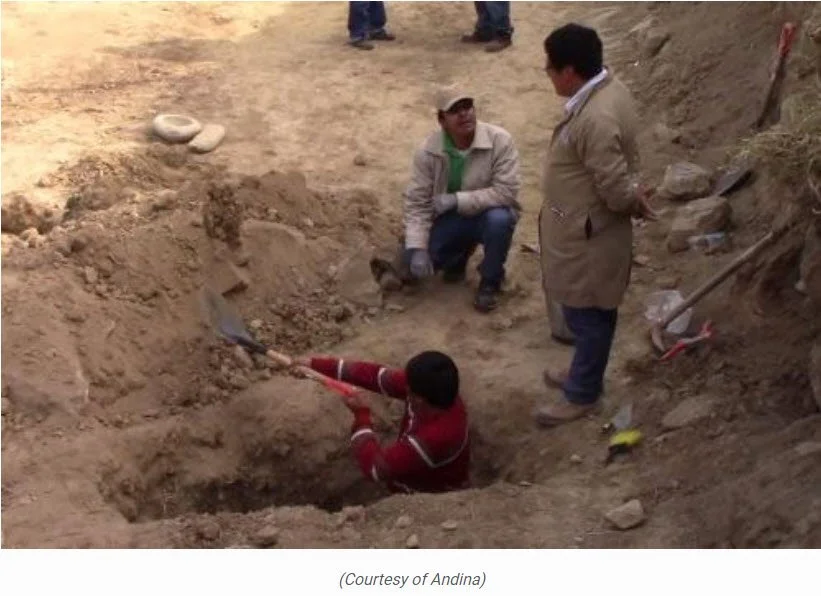Peruvian Archaeology. Fall 2018
All Bundled Up
By MARLEY BROWN
Sept/Oct 2018
Archaeologists working at Pachacamac, a pre-Columbian pilgrimage site and ceremonial center on the coast of Peru, have uncovered a well-preserved mummy buried sometime between A.D. 1000 and 1200. The team discovered the mummy while excavating remains of a structure once devoted to local ancestors. The building appears to have been transformed into a ritual healing facility when the Inca Empire absorbed Pachacamac in the late fifteenth century. “We knew there was an important cemetery beneath the building, which had been continually looted since the Spanish conquest in 1533,” says Peter Eeckhout of the Université libre de Bruxelles, who has directed excavations at the site since 1999. “Finding the burial in such a perfect state is miraculous.” Researchers will soon examine the mummy using medical imaging and 3-D reconstruction technology to determine the individual’s position within the bundle, detect possible diseases or injuries, and discover any grave goods included with the remains.
https://www.archaeology.org/issues/310-1809/trenches/6879-trenches-peru-pachacamac-mummy
Archaeologists unearth 3,800-year-old wall relief in Peru
Date 17.08.2018
Wall carvings were found in what was once a fishing city of the Caral civilization, the oldest in the Americas. The relief is thought to symbolize a period of drought and famine brought on by climate change.
Archaeologists discovered an ancient wall relief in Peru, belonging to the oldest civilizations in the Americas, news agency Andina reported on Thursday. The wall is approximately 3,800 years old and portrays snakes and human heads.
One meter (3.2 feet) high and 2.8 meters long, the wall relief was discovered in the sea-side archaeological site of Vichama, 110 kilometers (68 miles) north of Peru's capital, Lima.
The Vichama site is one of the excavation points of the recently discovered Caral civilization, also known as Norte Chico, and has been explored by archaeologists since 2007.
The Caral civilization is 5,000 years old, making it the oldest civilization in the Americas, and flourished at the same time as the thriving Mesopotamian, Egyptian and Chinese civilizations. The Caral people lived in the Supe Valley along the north-central coast of Peru.
Dating back to 1800 and 3500 B.C., Vichama is thought to have been a fishing community and one of the Caral peoples' various cities. The wall was made of adobe, a clay-like material from which bricks are made and was located at the entry point of a ceremonial hall.
Documenting climate change
The wall relief shows four human heads, side by side, their eyes closed, with two snakes passing between and around them. The snakes point their heads to what appears to be a humanoid seed symbol that is digging into the soil.
Archaeologist Ruth Shady, who oversees the site and announced the discovery, hypothesized that the serpents represent a water deity that irrigates the earth and makes seeds grow.
Shady said the relief was likely done towards the end of a drought and famine that the Caral civilization experienced. Other reliefs discovered nearby showed emaciated humans.
Archaeologists believe that the relief discovery reinforces the notion that these early humans were attempting to depict the difficulties they faced due to climate change and water scarcity, which had a large impact on their agricultural production.
The Caral excavation site has so far unearthed the ruins of 22 buildings in a 25-hectare space, dating back to between 1800 and 1500 B.C.
https://www.dw.com/en/archaeologists-unearth-3800-year-old-wall-relief-in-peru/a-45112955
Pre-Incan archaeological remains found in Huancayo
MICHAEL KRUMHOLTZ Article Updated: August 3, 2018
Archaeologists working at the Wariwillka site in Huancayo have dug up what they are calling evidence of a pre-Incan culture known as the Wari. Peru’s Culture Ministry confirmed the findings Thursday after they were accidentally discovered when a construction project leveled off a structure in the area.
“We are recovering and safeguarding archaeological heritage in accordance with National Cultural Heritage Law,” on-site archaeologist Ronald Sullca told state-run news agency Andina. “We’ve found some lithic remains, fragments of ceramics, human bone remains, and a salvage procedure is being performed before handing them over to Culture Ministry for their protection.”
It is initially believed that the findings are from the Wari culture, which was present from around 500 to 1000 AD in a large portion of Peru, mainly along the coastline. However, the exact location of the findings was a popular zone for numerous civilizations over the course of different centuries.
“We are going to analyze them (the bones and artifacts) to determine whether they belong to Wari period since the place is located 100 meters away from the archaeological complex of Wariwillka, known as Wankas’ place of origin,” Sullca said.
The current dig area is private land of 500-square meters owned by a local man named Porfirio Aquino who bought it a few decades ago.
Another archaeologist on site commented to Andina that the current excavation spot was most likely a burial site for the Wari culture.
https://perureports.com/2018/08/03/pre-incan-archaeological-remains-found-in-huancayo/
Photo of the day
Repatriated archaeological pieces from different Peruvian ancient cultures are shown at the Ministry of Foreign Affairs in Lima, on September 20, 2018. The 1.785 repatriated pieces come from countries such as Argentina, Australia, Colombia, Ecuador, United States, Netherlands, United Kingdom, Sweden and Switzerland, according to the Peruvian Chancellor, Nestor Popolizio. ERNESTO BENAVIDES / AFP
http://artdaily.com/index.asp?int_sec=4&int_dif=2





